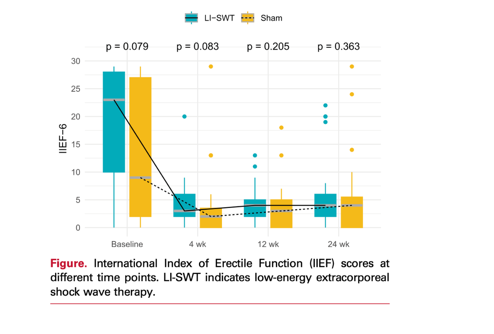Pedersen TB. et al., 2025: A Prospective Randomized Study on Low-Energy Extracorporeal Shock Wave Therapy for Erectile Dysfunction After Radical Prostatectomy.
Torben Brøchner Pedersen 1 2, Caroline Secher 1 2, Ali Moumneh 1, Nanna Hvid 1, Martin Lund 1, Grzegorz Fojecki 1, Lars Lund 1 2
1Department of Urology, Odense University Hospital, Odense, Denmark.
2Odense Patient Data Explorative Network (OPEN), Odense University Hospital, Odense, Denmark.
Abstract
Purpose: We evaluate the efficacy of low-energy extracorporeal shock wave therapy (LI-SWT) compared with a sham treatment in improving erectile function in men after radical prostatectomy. Erectile function was assessed using the Erection Hardness Score (EHS) and International Index of Erectile Function (IIEF) at baseline and 4, 12, and 24 weeks after treatment.
Materials and methods: A total of 75 participants were randomized to either LI-SWT or sham treatment. Data were analyzed using a zero-inflated negative binomial model for IIEF scores and appropriate nonparametric methods for the ordinal EHS data, including binary transformation for clinically relevant outcomes.
Results: The zero-inflated model for IIEF scores showed no significant difference between treatment groups with a ratio of 1.2 (95% CI: 0.1-2.4, P = .469). At 24 weeks posttreatment, the estimated median IIEF score was 4 in the LI-SWT group compared with 4 in the sham group. For EHS, no significant treatment effect was found, with median scores at 24 weeks of 2 in the LI-SWT group vs 2 in the sham group. The proportion of patients achieving sufficient erection hardness (EHS ≥3) at 24 weeks was 18% (95% CI: 9%-34%) in the LI-SWT group vs 26% (95% CI: 14%-43%) in the sham group (P = .552).
Conclusions: This study did not demonstrate a statistically significant improvement in erectile function for men undergoing LI-SWT compared with sham treatment after radical prostatectomy.
J Urol. 2025 Aug;214(2):156-166. doi: 10.1097/JU.0000000000004576. Epub 2025 Apr 27.
PMID: 40287933


Comments 1
Purpose: The study aims to evaluate the efficacy of low-energy extracorporeal shock wave therapy (LI-SWT) compared to a sham treatment in improving erectile function in men experiencing erectile dysfunction (ED) post-radical prostatectomy (RP).

Materials and Methods: A total of 75 men who developed ED following RP were randomly assigned to either the LI-SWT treatment group or the sham treatment group. Participants had to be between 20 and 80 years of age and should have had been in a relationship for more than 3 months. All participants had to be sexually active and capable of providing informed consent
The shock wave device used for this study (Duolith SD1 T-Top from Storz Medical) generates focused shock wave applying the electromagnetic principle. The device was set at 0.15 mJ/mm2, 5 Hz, with a total of 3000 impulses and a total energy of 12.8 J per treat- ment. The LI-SWT treatment was administered at 6 lo- cations on the penis (distal, center, and proximal parts of each cavernous body) by a therapist specifically trained for this procedure. In the sham-group, the handpiece was equipped with a shock wave absorbent material.
.
Outcome Measures included the Erection Hardness Score (EHS) and the International Index of Erectile Function (IIEF). Data were collected at baseline and then again at 4, 12, and 24 weeks after treatment.
Results:
- IIEF Scores: The analysis revealed no significant difference between the LI-SWT and sham treatment groups, with a treatment ratio of 1.2 (95% CI: 0.1-2.4, P = .469). At 24 weeks post-treatment, the estimated median IIEF score was 4 for both the LI-SWT and sham groups.
- EHS Scores:There was no significant treatment effect noted, as median EHS scores at 24 weeks were also identical: 2 for both groups.
- Proportion of Patients with Sufficient Erection Hardness (EHS more equal 3) at 24 weeks were 18% of participants in the LI-SWT group compared to 26% in the sham group, which was not statistically significant (P = .552).
Conclusions: The study did not find statistically significant improvements in erectile function for men undergoing low-energy extracorporeal shock wave therapy compared to sham treatment after radical prostatectomy. These results suggest that LI-SWT may not be an effective intervention for this patient population.
Implications: Given the findings, further research is required to explore alternative therapies for post-RP erectile dysfunction as well as to better understand the mechanisms of ED recovery following radical prostatectomy. The absence of benefit from LI-SWT in this study raises questions about its role in symptomatic management of erectile dysfunction in the post-surgical context. On the other hand, the study also shows the poor results of nerve-sparing surgery even performed by experienced surgeons (18-26%).
Recommendations: Future studies should consider larger sample sizes, longer follow-up periods, and potentially different parameters for shock wave therapy to ascertain any improvements in erectile function post-RP. Additionally, exploring combined therapies (ie. Li-ESWT plus Taldalafil) based onpatient-specific factors may yield more promising results.Moreover, the used shock-wave energy used in this study was relatively low (0.15 mJ/mm2).
Jens Rassweiler